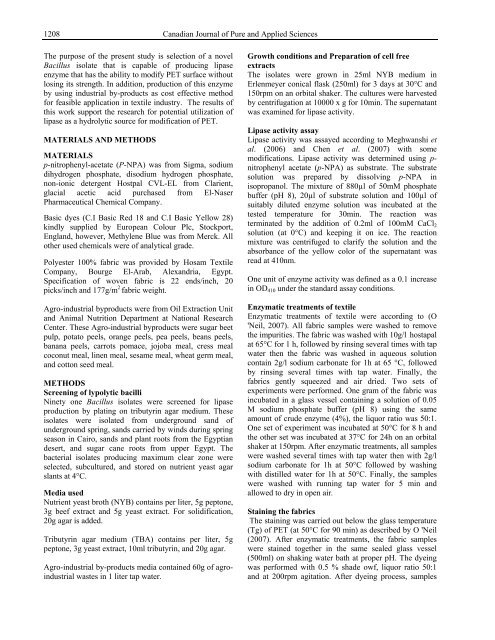Download (5Mb) - Covenant University Repository
Download (5Mb) - Covenant University Repository
Download (5Mb) - Covenant University Repository
You also want an ePaper? Increase the reach of your titles
YUMPU automatically turns print PDFs into web optimized ePapers that Google loves.
1208<br />
The purpose of the present study is selection of a novel<br />
Bacillus isolate that is capable of producing lipase<br />
enzyme that has the ability to modify PET surface without<br />
losing its strength. In addition, production of this enzyme<br />
by using industrial by-products as cost effective method<br />
for feasible application in textile industry. The results of<br />
this work support the research for potential utilization of<br />
lipase as a hydrolytic source for modification of PET.<br />
MATERIALS AND METHODS<br />
MATERIALS<br />
p-nitrophenyl-acetate (P-NPA) was from Sigma, sodium<br />
dihydrogen phosphate, disodium hydrogen phosphate,<br />
non-ionic detergent Hostpal CVL-EL from Clarient,<br />
glacial acetic acid purchased from El-Naser<br />
Pharmaceutical Chemical Company.<br />
Basic dyes (C.I Basic Red 18 and C.I Basic Yellow 28)<br />
kindly supplied by European Colour Plc, Stockport,<br />
England, however, Methylene Blue was from Merck. All<br />
other used chemicals were of analytical grade.<br />
Polyester 100% fabric was provided by Hosam Textile<br />
Company, Bourge El-Arab, Alexandria, Egypt.<br />
Specification of woven fabric is 22 ends/inch, 20<br />
picks/inch and 177g/m 2 fabric weight.<br />
Agro-industrial byproducts were from Oil Extraction Unit<br />
and Animal Nutrition Department at National Research<br />
Center. These Agro-industrial byproducts were sugar beet<br />
pulp, potato peels, orange peels, pea peels, beans peels,<br />
banana peels, carrots pomace, jojoba meal, cress meal<br />
coconut meal, linen meal, sesame meal, wheat germ meal,<br />
and cotton seed meal.<br />
METHODS<br />
Screening of lypolytic bacilli<br />
Ninety one Bacillus isolates were screened for lipase<br />
production by plating on tributyrin agar medium. These<br />
isolates were isolated from underground sand of<br />
underground spring, sands carried by winds during spring<br />
season in Cairo, sands and plant roots from the Egyptian<br />
desert, and sugar cane roots from upper Egypt. The<br />
bacterial isolates producing maximum clear zone were<br />
selected, subcultured, and stored on nutrient yeast agar<br />
slants at 4°C.<br />
Media used<br />
Nutrient yeast broth (NYB) contains per liter, 5g peptone,<br />
3g beef extract and 5g yeast extract. For solidification,<br />
20g agar is added.<br />
Tributyrin agar medium (TBA) contains per liter, 5g<br />
peptone, 3g yeast extract, 10ml tributyrin, and 20g agar.<br />
Agro-industrial by-products media contained 60g of agroindustrial<br />
wastes in 1 liter tap water.<br />
Canadian Journal of Pure and Applied Sciences<br />
Growth conditions and Preparation of cell free<br />
extracts<br />
The isolates were grown in 25ml NYB medium in<br />
Erlenmeyer conical flask (250ml) for 3 days at 30°C and<br />
150rpm on an orbital shaker. The cultures were harvested<br />
by centrifugation at 10000 x g for 10min. The supernatant<br />
was examined for lipase activity.<br />
Lipase activity assay<br />
Lipase activity was assayed according to Meghwanshi et<br />
al. (2006) and Chen et al. (2007) with some<br />
modifications. Lipase activity was determined using pnitrophenyl<br />
acetate (p-NPA) as substrate. The substrate<br />
solution was prepared by dissolving p-NPA in<br />
isopropanol. The mixture of 880µl of 50mM phosphate<br />
buffer (pH 8), 20µl of substrate solution and 100µl of<br />
suitably diluted enzyme solution was incubated at the<br />
tested temperature for 30min. The reaction was<br />
terminated by the addition of 0.2ml of 100mM CaCl2<br />
solution (at 0°C) and keeping it on ice. The reaction<br />
mixture was centrifuged to clarify the solution and the<br />
absorbance of the yellow color of the supernatant was<br />
read at 410nm.<br />
One unit of enzyme activity was defined as a 0.1 increase<br />
in OD410 under the standard assay conditions.<br />
Enzymatic treatments of textile<br />
Enzymatic treatments of textile were according to (O<br />
'Neil, 2007). All fabric samples were washed to remove<br />
the impurities. The fabric was washed with 10g/l hostapal<br />
at 65°C for 1 h, followed by rinsing several times with tap<br />
water then the fabric was washed in aqueous solution<br />
contain 2g/l sodium carbonate for 1h at 65 °C, followed<br />
by rinsing several times with tap water. Finally, the<br />
fabrics gently squeezed and air dried. Two sets of<br />
experiments were performed. One gram of the fabric was<br />
incubated in a glass vessel containing a solution of 0.05<br />
M sodium phosphate buffer (pH 8) using the same<br />
amount of crude enzyme (4%), the liquor ratio was 50:1.<br />
One set of experiment was incubated at 50°C for 8 h and<br />
the other set was incubated at 37°C for 24h on an orbital<br />
shaker at 150rpm. After enzymatic treatments, all samples<br />
were washed several times with tap water then with 2g/l<br />
sodium carbonate for 1h at 50°C followed by washing<br />
with distilled water for 1h at 50°C. Finally, the samples<br />
were washed with running tap water for 5 min and<br />
allowed to dry in open air.<br />
Staining the fabrics<br />
The staining was carried out below the glass temperature<br />
(Tg) of PET (at 50°C for 90 min) as described by O 'Neil<br />
(2007). After enzymatic treatments, the fabric samples<br />
were stained together in the same sealed glass vessel<br />
(500ml) on shaking water bath at proper pH. The dyeing<br />
was performed with 0.5 % shade owf, liquor ratio 50:1<br />
and at 200rpm agitation. After dyeing process, samples

















